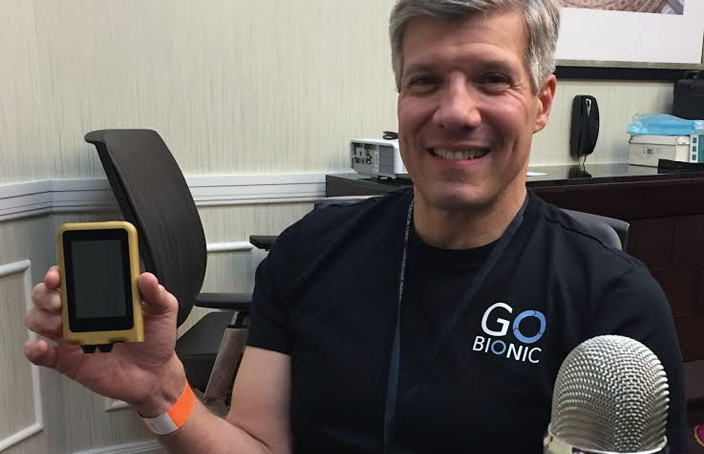It was July 2015 when Dr Edward Damiano (pictured) introduced the world to the iLet, a bionic pancreas that could revolutionise type 1 diabetes treatment, but how far away are we from seeing the device bought to market?
The cleverly named iLet – adapted from islet cells in the pancreas – has been called a “bridge to a cure” by Damiano, and people with type 1 diabetes are understandably excited to see the device in action.
Before we evaluate the progress of the iLet, here is a little back-story regarding the device.
Damiano explained at a TED talk last year that the bionic pancreas is “a synergistic system that automatically regulates blood sugar in type 1 diabetes”.
The iLet is a single hand-held unit that consist of three components.
Firstly, users wear a continuous glucose sensor on the body. This sends glucose levels directly the device (with sensors needing to be changed roughly once a week).
The iLet contains both insulin and glucagon, and controls two built-in pumps that deliver insulin and glucagon through tiny tubes that exit the bottom of the device and connect to thin catheters that enter the skin.
A series of mathematical algorithms then make therapeutic decisions to determine how much insulin and glucagon to deliver every five minutes.
“You can put this device in your pocket,” said Damiano. “It’s about the size of an iPhone, but twice as thick. And it truly takes over diabetes management.”
It solves four of the leading concerns in type 1 diabetes management, according to Damiano.
These comprise bringing average glucose levels down to levels that would stave off long-term complications; controlling hypoglycemia, preventing mild hypos and eradicating severe hypos; unburdening people from the stress of taking care of their diabetes; and freeing people from the emotional stress of the fear of hypos and long-term complications.
Bionic pancreas clinical trials
Damiano works for Boston University and Massachusetts General Hospital. After his son, David, was diagnosed with type 1, he wanted to build a technology that could help his son automatically manage his blood sugar levels.
Damiano and colleagues spent most of the previous decade developing the iLet, which “began as a research project [and] turned into an all-consuming determined effort to build an automated glucose control system”.
Since 2010, the iLet has undergone multiple outpatient clinical trials. A 2014 outpatient study found that the bionic pancreas outperformed an insulin pump for improving blood glucose levels with less hypoglycemia. Then, in 2016, a trial published in The Lancet Diabetes and Endocrinology journal showed similar findings: the iLet improved mean blood glucose and reduced hypoglycemia compared to a pump in preadolescent children with type 1 diabetes.
In this study, Damiano and colleagues stressed that studies of a longer duration are needed, particularly in children so that home and school routines can be evaluated.
When could the iLet be launched?

In October 2015, Damiano founded Beta Bionics, a benefit corporation, which has focused on fundraising and achieving regulatory approval for the device.
Earlier this year, Beta Bionics secured $5 million from pharmaceutical giants Eli Lilly, which manufactures the insulin used in the iLet. The company has also negotiated and licensed the intellectual property related to the bionic pancreas technology from Boston University.
Beta Bionics is currently enrolling for the Bionic Pancreas Pivotal Trial in 2017, which will see 600 subjects with type 1 diabetes aged 13 and older test the device.
Damiano is hoping this clinical data will prove enough for a pre-market approval application to the US Food and Drink Administration (FDA) for two versions of the device: insulin-only, and the full bihormonal configuration system.
At this stage, Damiano’s team is still seeking third-party contract manufacturers to produce the iLet, with Beta Bionics unable to do so.
But their goal is to have the insulin-only version approved by the FDA in 2018, and for the full system to be approved shortly afterwards.
Why all the excitement?
The bionic pancreas is not a cure for type 1 diabetes, but it is pretty close.
“It’s a turnkey solution for type 1 diabetes,” said Damiano. “You input your weight and it begins adapting to your every-changing insulin needs.
“The bionic pancreas doesn’t discriminate against age, gender, race or even how well or poorly you manage your diabetes.
“It truly is a game-changing technology. It is an innovative technology unlike anything we’ve seen since the discovery and purification of insulin.”
Next year’s Pivotal Clinic Trial will be a major moment in the history of type 1 diabetes. Many people with the condition would likely want to own the device, and while development is far from complete, and it could still take a few years to come to market, the iLet is arguably one of the most significant developments in modern medicine.
Here’s hoping we get it sooner rather than later.
Main image: heathline.com



